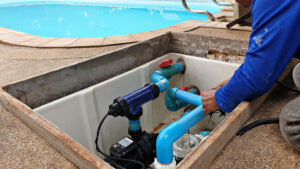How Can You Fix Broken Pumps And Leaking Valves?

Pumps play a critical role in many industries and also in the domestic space.
Water is the most essential resource for life and by using pumps, we are able to extract it from natural sources, process it to make it useful, and distribute it across our ever-growing cities. In countries where surface-level water bodies are scarce, people rely on powerful pumps to extract water from deep underground sources.
In many industries, water plays a critical role in the production process. However, pumps are also used frequently for moving other kinds of liquids, gasses, and even solids. Together with pumps, we need valves that help regulate the piping that is connected to the pump and manage how things are moved around in the system. A breakdown in a pump or a faulty valve can be a serious setback in any situation. Here are some of the main problems that occur with pumps and valves and their solutions.
Worm Replacement
To generate the movement in the pump, especially when moving very viscous liquids or semi-solid liquids pumps use worm drives. This is like a cooked shaft that spins in a circular motion to get things to move from one part of the pump to the other end of the pump body.
Over time, the worm itself or the body within which the worm is housed can wear out. This increases the space between the worm and the encapsulating body which lowers the pressure in the pump and reduces its efficiency. You can easily disassemble the water pump body and replace the worm on your own in simple domestic pumps. Larger, industrial-grade pumps may require specialized machinery to replace the worm.
Rewinding The Motor
Another very common problem with water pumps is motor failure. Motors provide the pump with the rotational force that it needs to move the liquid, gas, or solid material it is designed to move. The motor can fail due to a variety of reasons including overheating, exposure to water, over or under voltage spikes, shaft deformations, among others. These problems can break, burn or damage both copper winding motors and silver winding motors.
If you have the right tools for the job and you can make a few basic calculations to find out how much wire you need to generate the same amount of horsepower at the required speed, you can easily rewind the motor. With small motors, you can get away with silver winding but on larger motors, it becomes very inefficient to use anything other than high-quality copper.
Pump Seals
Even in very small centrifugal pumps, the pump body and all its connected parts experience a lot of pressure. The water is being compressed in one part of the body and then being forced out of the other end. The cast iron body can withstand this pressure for a long time but the thin, sensitive seals often don’t last that long.
Especially if you are pumping corrosive liquids such as acid through the pump, the seals will be the first thing to give way. If you use the pump for hot water or a corrosive substance your best bet is to contact a gasket manufacturer and have a seal made from a different material that can better withstand that kind of use. There are plenty of materials such as non-asbestos fiber, silicon, compounded rubber, and others, that stand up easily to harsh materials. Rather than relying on the OEM seal, you can use a different seal that will also help you maintain a higher pressure in the pump and get more efficiency out of it. Seal replacements should be a part of every repair or maintenance routine even if you have just disassembled the pump for a routine checkup, so be sure to stock up on plenty of seals.
Repairing Bearings
The pump shaft, the motor shaft, the fan, and any other moving part in the pump will all rely on having bearings around them to get them to spin freely. A faulty bearing is not only loud and annoying; it also places a lot of stress on the entire pumping mechanism and can be the culprit behind a complete pump and motor failure. When replacing or upgrading bearings, it is important to get the right type of bearing and the right size. Different bearings are designed for different applications. For instance, the bearings used on a high-speed water pump will be different from the bearings used on a slow pot mixer. The fact that they are the same size doesn’t automatically mean they can be used interchangeably.
In some cases, the bearing itself can be repaired or refurbished to be used again. The rolling element, whether that is a steel ball or a cylinder, can be replaced, and the entire unit can be lubed and reassembled. During this process, you need to use the right components that can withstand the pressure and the temperature that you intend to use them for. If you are running a high-risk operation like pumping water for a large building or private housing area it is best to use higher quality bearings that don’t need regular maintenance and have a longer service life.
Impeller Repair
Most pumps use an impeller to drive fluid through the pump body. Some pumps use a single impeller while others can use multiple impellers. Depending on the application that the pump is made for, the impeller can be made from many different materials but brass and plastic are two of the most popular options. If the pump has lost its pressure, is operating at a higher voltage or is having trouble maintaining a consistent suction from the suction end, there might be a problem with the impeller.
Impeller damage is more common in situations where the pump is drawing water from a natural source and there is no filtration in the inlet side. Small pebbles and stones can chip away on the fins of the impeller which reduces the effectiveness of the pump. If you are pumping muddy water the sand or soil can slowly grind away the blades on the impeller and again, it loses efficiency. Problems with the impeller can easily catch the drive shaft of the pump and this can, in turn, impact the motor causing you to lose both the motor and the pump. Make sure you are using the right kind of impeller and making the necessary changes to protect the impeller.
Valve Replacements
In any pumping system, valves play a critical role. Especially in situations where high-pressure liquids or gasses are being pumped, having the right valves is crucial. Just like other parts of the pumping system, the valves also deteriorate with extended use. This is particularly dangerous when you are dealing with hot water, flammable gasses, or any kind of high pressure. The most important valve to check is the safety valve. These come in many forms and the aim is to provide the system with an outlet in case things start to get dangerous. The pressure valve is commonly used in residential geysers to release steam.
In larger piping systems, valves help regulate the flow of water and they are used to direct water to different parts. If regular maintenance is not part of the schedule, it can be a big problem because replacing a large valve in a big piping network takes a lot of time. It costs a lot in downtime and it is difficult to do. For instance, large valves installed in sewage systems or city water supply systems can weigh hundreds of pounds. They are installed in tight spaces several feet underground, and if one valve is out of order an entire section of piping cannot be used. While the mechanics of valves is rather straightforward, actually repairing one can be quite technical. Get yourself a good quality valve and make sure it is rated to work for your task.
Balancing Problems
Some pumps are known as monoblocks. There is a single or ‘mono’ body that consists of both the motor and the pump. In larger pumps, such as large centrifugal pumps or engine-driven pumps, the motor and the pump are separate and they need to be ‘coupled’ to work. Coupling is the process of balancing the shafts of both components and assembling the system on a balanced platform.
If balancing isn’t done right it can result in a vibration in the system, poor pump performance, or it can even completely break the entire unit. Motors can spin extremely fast and large motors can have incredible amounts of torque. If the balancing is off by even a millimeter, it can spell disaster. Whenever you need to align pumping systems, make sure you are getting it done professionally and never risk doing it on your own.
When maintaining pumps and valves, one of the things that people often forget to check is the quality of the wiring. Remember, the wiring is what is responsible for transmitting current to the entire system, and without the right voltage, your entire system is at risk. It is very important to inspect the condition and the gauge of the wire in situations where the pump is far from the power source. For instance, submersible pumps can be running hundreds of feet of wire from the surface to deep in the ground where the pump is actually installed. A tear or break at any point in the wire can damage the pump and the motor and can also be a danger to the users if the water is carrying current.




